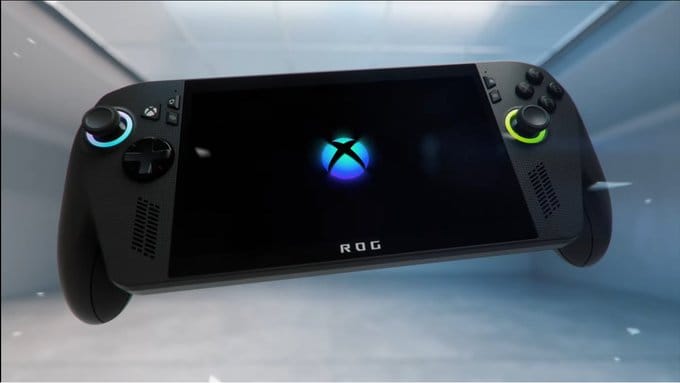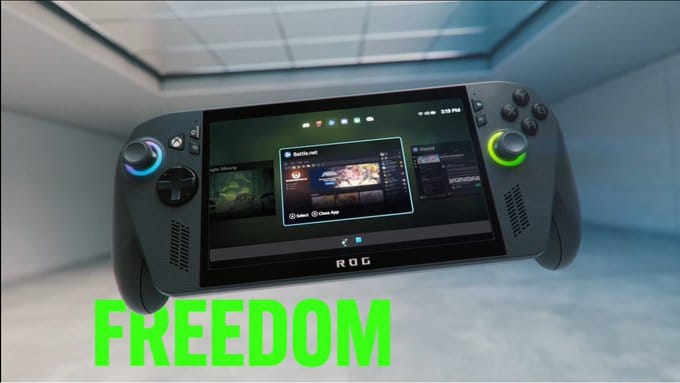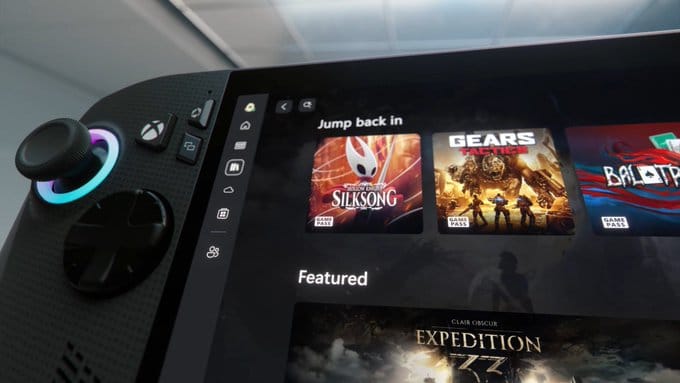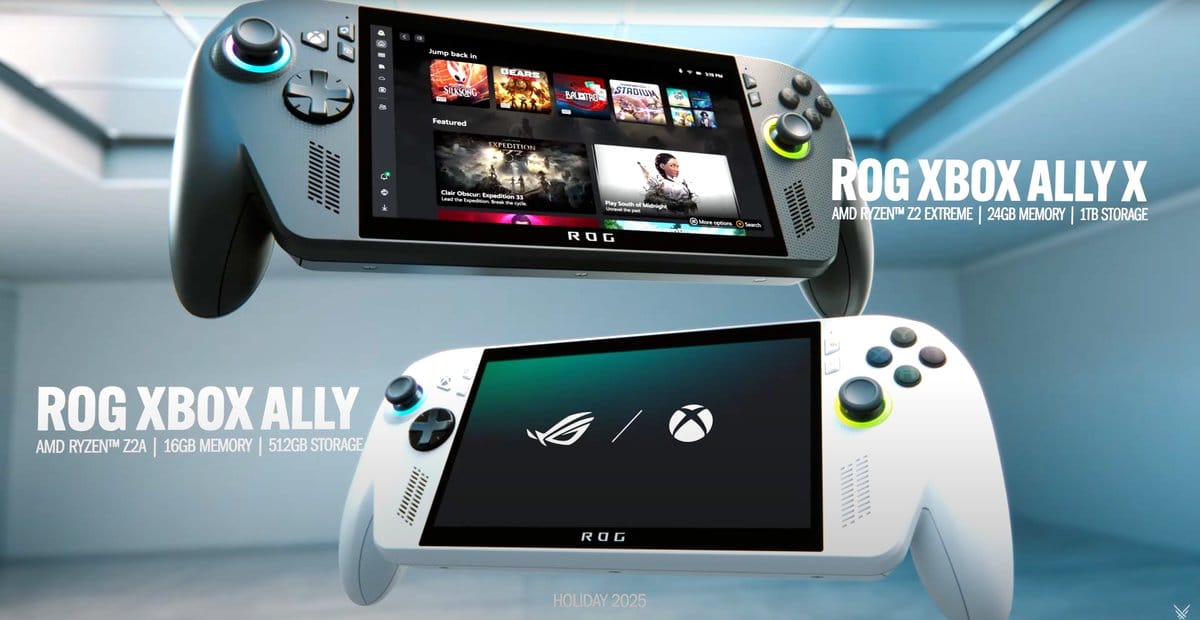As of 01:05 AM WIB on Monday, June 09, 2025 (8:05 PM BST, Sunday, June 08, 2025, in the UK), Microsoft, in collaboration with ASUS, has unveiled two groundbreaking handheld gaming devices: the Xbox Ally and the ROG Xbox Ally X. Announced just 47 minutes ago at approximately 12:18 AM WIB during the Xbox Games Showcase live presentation, these consoles are set to launch during the 2025 holiday season, marking Microsoft’s ambitious entry into the competitive handheld gaming market. Featuring enhanced integration with the Xbox ecosystem, powered by AMD’s Z2E and Z2A processors, and introducing a new full-screen Windows mode optimized for gaming, the Xbox Ally and Ally X promise to redefine portable gaming. This article explores the announcement, the devices’ technical specifications, their market significance, and the future of handheld gaming in light of this partnership.

The Announcement: A New Era for Xbox Gaming
The Xbox Ally and ROG Xbox Ally X were revealed to the world at the Xbox Games Showcase, a virtual event streamed globally, with the announcement breaking at around 12:18 AM WIB on June 09, 2025. Microsoft’s collaboration with ASUS, a leader in gaming hardware, signals a strategic pivot toward expanding the Xbox brand beyond traditional consoles and cloud gaming, as reported by variety.com. The launch aligns with Microsoft’s broader vision to integrate its Xbox ecosystem with Windows, offering players seamless access to a vast library of games across platforms. Phil Spencer, CEO of Microsoft Gaming, described the move as “a natural evolution of Xbox, bringing the power of our ecosystem to the palm of your hand,” highlighting the company’s intent to compete with established handheld leaders like the Steam Deck and Nintendo Switch.
The timing of the announcement, just before the holiday season, is strategic, targeting gamers eager for new devices during the peak shopping period. The showcase featured live demonstrations of the devices running titles like Clair Obscur: Expedition 33, Gears of War: Reloaded, and Lies of P, showcasing their capability to handle AAA games on the go. ASUS’s Republic of Gamers (ROG) brand, known for high-performance PCs, brings its expertise to the partnership, ensuring the devices meet the demands of serious gamers. This collaboration, detailed by videocardz.com, builds on Microsoft’s earlier hints of handheld ambitions, shifting focus from a native Xbox handheld to optimizing Windows-based devices, a decision.

Technical Specifications: Power in Your Hands
The Xbox Ally and ROG Xbox Ally X are designed to deliver console-quality gaming in a portable form, leveraging AMD’s latest Ryzen Z2 series processors. Here’s a breakdown of their specifications, based on details from variety.com and rog.asus.com:
- Xbox Ally:
- Processor: AMD Ryzen Z2A, balancing performance and power efficiency.
- RAM: 16GB, sufficient for modern gaming demands.
- Storage: 512GB SSD, expandable via microSD, offering ample space for games.
- Display: 7-inch Full HD (1920x1080) touchscreen with a 120Hz refresh rate and FreeSync Premium, ensuring smooth visuals.
- Battery Life: Up to 8 hours, optimized for casual play, with fast charging support.
- Features: Dedicated Xbox button, contoured grips, and accessibility options inherited from Xbox consoles.
- ROG Xbox Ally X:
- Processor: AMD Ryzen Z2 Extreme, delivering higher performance for demanding titles.
- RAM: 24GB, enhancing multitasking and support for graphically intensive games.
- Storage: 1TB SSD, doubling the base model’s capacity for larger game libraries.
- Display: 7-inch Full HD (1920x1080) with a 120Hz refresh rate and FreeSync Premium, matching the Ally’s visual quality.
- Battery Life: Up to 12 hours, ideal for extended gaming sessions, with improved thermal management.
- Features: Enhanced cooling with the Zero Gravity thermal system, customizable keymaps via ROG Armoury Crate SE, and Aura Sync lighting.
Both devices boot directly into a new full-screen Xbox experience, a feature optimized for handheld gaming, as announced by variety.com. This mode minimizes background activity and defers non-essential tasks, dedicating more system resources to gameplay for higher frame rates and an immersive experience. The integration with Windows 11 allows access to Xbox Game Pass Ultimate, Steam, and Epic Games Store titles, broadening the gaming library. The inclusion of a dedicated Xbox button and ergonomic design reflects Microsoft’s focus on user familiarity and comfort.

Market Significance: Xbox Enters the Handheld Arena
Microsoft’s entry into the handheld gaming market with the Xbox Ally and Ally X is a bold move, challenging established players like Valve’s Steam Deck, ASUS’s own ROG Ally, and Nintendo’s Switch. The partnership with ASUS leverages the latter’s manufacturing prowess and gaming heritage, positioning the devices as premium alternatives in a growing sector. According to videocardz.com, the handheld gaming market is projected to reach $20 billion by 2026, driven by demand for portable, high-performance gaming, making this launch timely.
The Xbox Ally, priced at an estimated $399 (based on industry trends for similar devices), targets cost-conscious gamers seeking Xbox integration, while the Ally X, likely around $599, appeals to enthusiasts willing to pay for superior performance and storage, as speculated by variety.com. This dual-tier strategy mirrors Nintendo’s approach with the Switch and Switch OLED, aiming to capture both casual and hardcore markets. The inclusion of three months of Xbox Game Pass Ultimate with each device, as noted by rog.asus.com, adds significant value, offering access to hundreds of games and enhancing the consoles’ appeal during the holiday season.
The full-screen Xbox mode, a first for Windows handhelds, addresses a key criticism of previous devices like the original ROG Ally—namely, the cumbersome controller navigation on a desktop interface, as highlighted by windowscentral.com. By optimizing Windows for gaming, Microsoft and ASUS aim to provide a console-like experience, potentially setting a new standard for the industry. This move also aligns with Microsoft’s shift away from a native Xbox handheld, focusing instead on third-party collaborations, a strategy clarified by an earlier windowscentral.com report on Project Kennan’s reprioritization.
Implications for Gamers and Industry
The launch of the Xbox Ally and Ally X signals a transformative moment for handheld gaming, offering unprecedented access to Xbox’s ecosystem. Players can now enjoy titles like Halo Infinite and Forza Horizon 5 on the go, with cloud streaming enhancing performance for less demanding hardware configurations, as demonstrated during the showcase. This integration strengthens Xbox Game Pass’s value proposition, potentially increasing subscriptions and challenging competitors like PlayStation, which lacks a dedicated handheld.
For ASUS, the partnership reinforces its ROG brand’s dominance in gaming peripherals, expanding its portfolio beyond PCs and monitors. The collaboration could also influence other manufacturers, such as Lenovo with its Legion Go, to adopt similar Xbox-optimized features, as Microsoft plans to roll out the full-screen mode to other Windows handhelds in 2026, per windowscentral.com. This could lead to a new era of standardized handheld gaming interfaces, fostering competition and innovation.
The devices’ launch during the 2025 holiday season, a peak sales period, is poised to capitalize on consumer spending, with pre-orders likely opening in late summer. Analysts predict strong demand, particularly in North America and Europe, where Xbox has a loyal fanbase. However, the market faces challenges, including supply chain constraints and competition from the Steam Deck’s open-platform appeal, which may require Microsoft to ensure competitive pricing and availability.
Challenges and Future Prospects
Despite the excitement, the Xbox Ally and Ally X face several hurdles. Battery life, while improved, remains a concern for extended play, especially for the Ally X’s more powerful Z2 Extreme chip, which may generate additional heat. The Zero Gravity thermal system, praised by rog.asus.com, aims to mitigate this, but real-world testing will determine its effectiveness. Additionally, the devices’ reliance on Windows 11 could introduce software optimization challenges, a point raised by windowscentral.com, potentially requiring post-launch updates to ensure stability.
Regulatory and market acceptance are other considerations. The handheld gaming sector is still niche, with consumers accustomed to dedicated consoles or mobile gaming. Microsoft’s success will depend on marketing the Xbox Ally as a complementary device, not a replacement, for existing Xbox Series X|S owners. Partnerships with game developers to optimize titles for the handheld’s hardware could further drive adoption.
Looking ahead, the 2026 rollout of the full-screen mode to other devices, as planned by Microsoft, could expand the ecosystem, encouraging third-party manufacturers to align with Xbox. Future iterations might include enhanced AI features, leveraging AMD’s Ryzen AI capabilities, or modular designs for upgraded components, as speculated by videocardz.com. The holiday 2025 launch could also pave the way for a mid-cycle refresh in 2027, incorporating next-gen processors or improved displays, aligning with Microsoft’s long-term handheld ambitions.
Conclusion: A Holiday Gift for Gamers
Announced just 47 minutes ago at 12:18 AM WIB on June 09, 2025, the Xbox Ally and ROG Xbox Ally X mark a pivotal moment in Microsoft’s gaming strategy, launched in partnership with ASUS for the 2025 holiday season. Powered by AMD’s Z2E and Z2A chips, featuring a revolutionary full-screen Xbox mode, and offering seamless access to a vast game library, these handhelds promise to bring console gaming to new heights of portability. With an estimated launch window spanning November to December 2025, the devices are poised to captivate gamers worldwide.
For Microsoft, this venture represents a bold step into the handheld market, leveraging its Xbox ecosystem to challenge competitors and redefine portable play. For ASUS, it strengthens the ROG brand’s reputation as a gaming innovator. As 2025 progresses, the success of the Xbox Ally and Ally X will depend on execution—delivering on performance, battery life, and software optimization—while setting the stage for a future where gaming knows no boundaries. Today’s announcement is not just a product launch; it’s a glimpse into the next chapter of interactive entertainment, arriving just in time for the holiday season.


